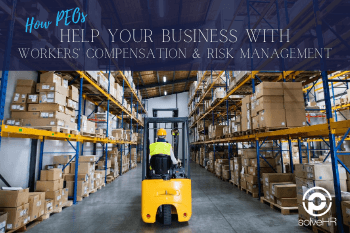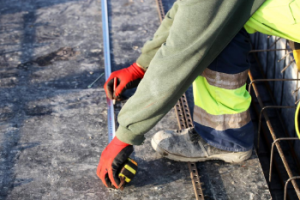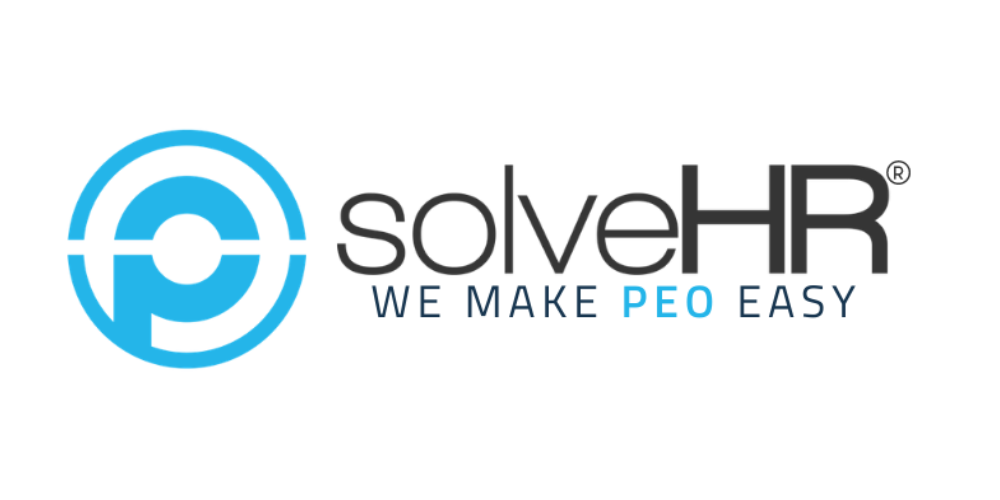- 07/29/2020
- Posted by: SolveHR-IT
- Categories: Risk & Compliance, Small and Mid-Sized Business

There is an element of risk you take when you start a business. It is an inherent facet of the entrepreneurial spirit that to gain something you must risk losing something in exchange. Managing this risk is an essential part of being able to stay in business; whether that risk is the direction you take your company in or everyday business risk like employee injuries.
This week we wanted to talk about how PEOs can help you with risk management and workers’ compensation. These two topics are big areas of improvement for companies, as identifying where the possibility of risk allows you to prevent problems and disasters from happening beforehand.
 Risk Management
Risk Management
We’ll start talking about risk management first because it leads to our discussion of workers’ compensation. Risk management is the process of identifying possible risks, problems, or disasters before they happen to allow you to set up procedures to avoid the risk, mitigate its impact, or, at the very least, deal with the consequences of its impact.
For example, take the Texas grocery store chain H-E-B. At the start of the 2020 COVID-19, pandemic many businesses scrambled to get a pandemic plan together as the virus swept across the United States. As supply chains were shocked by the rush of shoppers’ panic buying, H-E-B’s shelves remained stocked and social distancing measures got put in place swiftly to protect shoppers and employees.
Why was H-E-B one of the only grocery store chains in Texas to rapidly handle the pandemic response? Because they’ve been preparing since 2005. According to an article from Texas Monthly, H-E-B started communicating with Chinese retailers since January and have had a pandemic and influenza response since 2005, when the threat of H5N1 was occurring in China at the time.
If you got told in November of 2019 that H-E-B was doing this then you would have thought they were crazy, but that is the thing about risk and preparing for it. Even if the pandemic hadn’t hit the U.S. so hard, H-E-B would have at least had all their bases covered if something did happen in the future.
This is where PEOs can help you with risk management and be more prepared for the unthinkable. PEOs are staffed with risk management specialists who can help you oversee your business and see where the risk lies. Whether its everyday risks like OSHA compliance and workers’ compensation, or larger risks like workplace safety during a pandemic, PEOs will have you covered.
Workers’ Compensation
This leads us to our next topic on risk, workers’ compensation. While the age-old adage says that employees are a company’s greatest asset it can be said that they are also they’re the greatest risk as well. When employees get hurt on the job, the Work Injury Compensation Act (WICA) allows them to make claims for work-related injuries or diseases without having to take legal action. By implementing proper risk management into your business, you can lower these costs by keeping employees safe.
The United States Department of Labor states that an effective safety and health program can save $4 to $6 for every $1 invested, and it has been estimated that employers in the U.S. pay almost $1 billion per week for direct workers’ compensation costs. That isn’t even accommodating the indirect costs of lost productivity, repairs on damaged equipment and property, and costs associated with lower employee morale!
Take a look at the OSHA’s Safety Pays Program, it is a helpful online tool that gives estimated indirect and direct costs of occupational injuries and illnesses. Some highlights from the program are:
- Amputation
- Direct Cost-$88,991
- Indirect Cost-$97,890
- Burn
- Direct Cost-$43,661
- Indirect Cost-$48,027
- Concussion
- Direct Cost-$52,120
- Indirect Cost-$57,332
- Hernia
- Direct Cost-$21,437
- Indirect Cost-$23,580
- Sprain
- Direct Cost-$30,798
- Indirect Cost-$33,877
It should be noted that the extent to which the employer pays the direct costs depends on the employer’s workers’ compensation insurance policy, and the employer always pays the indirect costs. Thus, safety should be prioritized to lower workers’ compensation costs and medical expenses, avoid costly OSHA penalties, and reducing costs to train replacement employees.
PEOs can help with workers’ compensation by ensuring that the workplace is OSHA compliant, dealing with worker’s comp claims, and managing your workers’ compensation insurance coverage. PEOs simply help with the administrative nightmare of having to juggle all of the rules and regulations that come with keeping the workplace safe.
Effective social distancing measures, pre-employment drug tests, safety training, or implementing back-to-work programs are just some of the ways that PEOs can help you manage risk and keep workers’ compensation costs down. Saving you money and keeping your workplace safe for your employees.
Are all of the OSHA regulations starting to boggle your mind? SolveHR offers a comprehensive safety management package that is guaranteed to keep your business compliant and your employees safe. Let SolveHR handle the hard stuff so you can focus on what’s important—growing your business!
Subscribe to receive all our blogs
Written by: Matthew Muriel
Meet Matthew! Matthew is our content writer and has been working with us for a year. He enjoys working for SolveHR because it allows him to practice his copywriting and allows him to build experience in his fledgling career. Matthew studied at the University of Texas at San Antonio and earned his degree in English with a concentration in Professional Writing. He values learning new processes in the HR industry and then conveying those ideas to the company’s clients. When he isn’t working, he enjoys reading nonfiction, with his favorite book that he recently read being The Gene by Siddhartha Mukherjee. If he could go anywhere in the world he would travel across the United States and visit all of the national parks.

